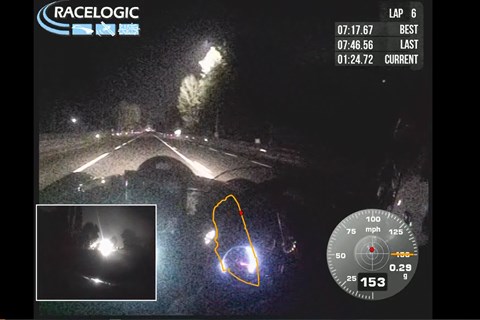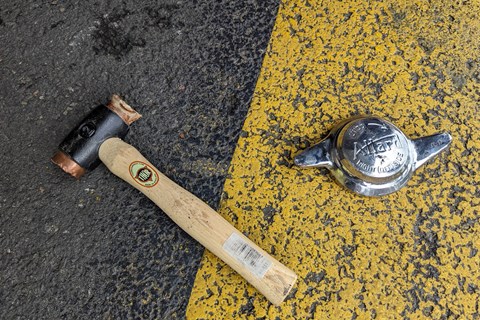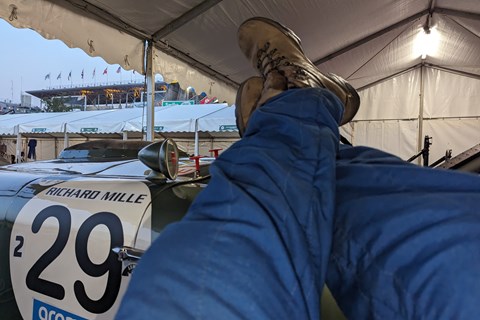► What it’s like to take on the Le Mans Classic
► In an Allard with a 5.4-litre V8 block
► 235,000 fans and 800 cars
It’s 2am. I’m wired, adrenaline streaming through my body as I steer a course down the iconic Mulsanne Straight in an ultra-rare 1952 Allard J2X Le Mans.
The steering’s light, for once. The thin-rimmed ‘wheel has a delicacy to its feedback as the sheer volume of air passing under the front end begins to lift it. This is juxtaposed with the roar of the 5.4 hemi V8, bellowing its music into the trees at somewhere above 5000rpm.

Everything feels right. It’s time to push and see what this monster will do. Foot down further, the car surges forwards as the revs climb higher. There’s a red shift light blinking at me from the dash, but there are no more gears.
In my peripheral vision the rev counter’s needle is bouncing indecipherably between 5000 and 6500rpm. Time has slowed. Soon I’ll need to lift to prevent engine failure, but not yet. Push on: the speedo reads above 150mph, and it’s still climbing. In the distance I can see the marker boards where I’ll be asking rather a lot of these drum brakes for the next chicane…
Welcome to historic motor racing. Welcome to the 2023 Le Mans Classic: the biggest historic motorsport gathering ever.
This event is usually (global pandemics aside) held every other year, and attracts hundreds of thousands of classic car fans from across the globe. This time’s slightly different, though, because we’re celebrating the centenary of racing at Circuit de la Sarthe.
The numbers are bewildering: 235,000 fans attended over the weekend, two weeks after the 24-hour race took place. There were over 800 historic racing cars, ranging from 1923 pre-war monsters to endurance legends from 2010. But furthermore there were 9200 motor club-sourced cars on show, live entertainment, hundreds of retail stands and loads of places to eat and drink.

My part was small, but unforgettable. I was one of over 900 racing drivers, and my task was to co-drive this attractive Allard with its owner Simon in grid two, which caters for cars built between 1949-1956. We were allocated three 45-minute races within 24 hours, so the organisers can fit all grids into the 24 hours the modern endurance race lasts for. The flag was due to fall for our grid at 17:45 Saturday, and then on Sunday at 01:30 and 09:00. In other words, there wasn’t going to be a lot of time for luxuries like sleeping.
We’d only raced the car successfully once, at Silverstone a few weeks before we headed to France. Testing time had been at a premium too, which left everybody involved wondering whether the car would be up to the task. Such is the nature of developing a machine like this: effectively it was a prototype racer in its day, and it remains so now.
The significance of this car is the reason it’s been allowed an entry. You may be familiar with Allards with cycle wings (like a Morgan), and indeed earlier J2Xs had these.

However, it was in 1952 that the regulations for Le Mans were changed dramatically, forcing entrants to use barchetta-style bodywork pushed to the outside of the wheels for the first time.

This was dubbed ‘envelope’ coachwork, and thus a completely new silhouette for Sydney Allard’s creations was ushered in. It’s around this time that companies began properly experimenting with aerodynamics too, although the streamlined shape of the J2X Le Mans wasn’t really optimised with that in mind. Hence the front end’s spriteliness at speed…

Underneath the hand-finished bodywork is a basic front-engine, rear-wheel drive set-up. The front end was a swing axle suspended on coil springs, while it had a De Dion rear axle, which necessitated the hydraulic drum brakes to be mounted in-board at the back of the car, with the quick-change differential sandwiched betwixt them.
Buyers had a choice of powerplant in the J2X, with most choosing either Cadillac or Chrysler V8s. This car uses the latter – specifically a FirePower 331CI (331 cubic inches, or 5.4 litres). This feeds its massive twist through a three-speed manual gearbox.
As you can imagine, a spec like that means this isn’t an easy car to master. You need to drive around the play in the steering to get it set up for bends, match your revs fastidiously to keep the body stable, brake in enough time to get its 1000kgs slowed, and yet still watch your throttle application – left off too hard and the rear end tries a crafty overtake. Too much exuberance and the same is true. This car requires thinking about to extract its performance, but when it all comes together, the rewards are huge.

We didn’t get off to a brilliant start. In race one, I didn’t get a look-in, as Simon took it out for the first laps of the famous 8.5-mile circuit and encountered a fuelling issues with the Rochester carbs, resulting in a rather spectacular fireball from the bonnet vent. He very sensibly parked the car at the side of the track and was recovered.

Luckily there wasn’t any serious damage and the brilliant mechanics, from Project Heaven in Northamptonshire, got the issue sorted in time for our 01:30 night race. Since we stopped after one lap, that effectively meant we finished in 78th position out of 87 cars, meaning that’s where we’d start race two…
This time, Simon did his full stint, pulling into the pits after the pit window opened, jumping out before I slid myself in behind the wheel.

I selected first gear and headed out of the pitlane, tracing the right-hand side of the Dunlop Corner, getting up to speed, and then into the Dunlop Chicane, through the Forest Esses, around Tetre Rouge and away up the Mulsanne Straight.
My first lap was a sighter, testing the grip of the Dunlop historic racing rubber and getting a feel for how the car performed in cooler conditions.
On lap two I felt more confident, having worked out my basic lines and where the flood lighting isn’t so great. That would be around the Porsche Curves and into the Ford Chicane, if you’re interested…
Anyway, things started to gel properly from this point on, and I pushed the car to its maximum speed of the weekend on this lap, 153mph on the first part of the Mulsanne Straight. In my four laps of night driving I overtook quite a few cars and experienced several ‘slow zones’ (double waved yellow flags; maximum speed limit 80km/h) before taking the chequered flag. We finished this race in 35th, which considering our starting position, we were fairly pleased with.

And then to race three, starting at 09:00 on Sunday after approximately 10 minutes of sleep in a paddock resonating with the scream of Group C racers, the rumble of Ford GT40s, and pretty much every other type of engine noise imaginable.
For me, this race was the highlight of the weekend. We’d agreed that finishing was the priority, and that we’d limit revs to 5.5k rpm with that in mind. We weren’t competing for a podium position anyway, so that seemed a prudent measure.
Simon had a great stint in the morning sunshine before I jumped in, headed out on circuit and really got to grips with the car. It all slotted into place – the tyres were warm, the gauges exactly where they should be and the handling completely on point. This allowed me to carry far more speed into corners that I had been previously, and as a result, ended up passing a decent amount of traffic on my way to a 20th position finish.

Our results don’t do justice to the feeling of elation we all felt when I pulled the car back into the paddock after the third session, having conquered everything Le Mans had thrown at us and ending it in a pretty respectable position, given many cars were on disc brakes (a massive performance advantage) and more modern suspension components and designs.
Our grid contained a number of Jaguar D-Types, Mercedes 300SLs and Ferraris that were highly competitive in the mid-50s, so we were never realistically going to beat them, particularly in our first big outing, but we certainly didn’t feel like we’d disgraced ourselves either.

The whole experience was one huge education for us, and we ended feeling sad that we weren’t driving again any time soon. The car needs a bit of work now, and we all have other commitments in the coming weeks, but keep an eye out for this Allard: it’s a quick car now, and we’re hoping to compete in some more big historic meetings in 2023…